|
Costa
Azul |
| Portugal > Tourism > Lisbon > Costa Azul > Nature and Environment |
|
From the coast to the interior, the sea to the hills and rolling plains of Setúbal, one can find a series of naturally enchanting values, both socio-economic and cultural; a diversity of which is difficult to find elsewhere. The need to conserve nature, landscape, heritage in harmony with the growing needs of a nounshing population has recently been responsible for the establishing of protected areas, one National Park, two Natural Reserves and an area of Protected landscape. The idea is to establish a closer contact between man and nature, keeping alive traditional activities and resources to provide for balanced development. |
| THE ARRÁBIDA'S NATURAL PARK (Guided Tour) |
|
The Arrábida Natural Park was formed in 1976 and covers an
area of 10,800 hectares. Setúbal, Palmela, Azeitão,
Sesimbra and the sea make up its boundaries. The countryside is hilly
and we can find the Serra dos Gaiteiros, S. Luís, S. Francisco,
Louro, Risco along with the highest hills, the Serra da Arrábida
which stands at 499 metres high. This ends abruptly and cuts into
the sea, providing a |
| NATURAL RESERVE OF THE SADO ESTUARY |
|
The Natural Reserve of the Sado Estuary, created in 1989 covers an
enormous area of 23,160 hectares. It was created to conserve nature
and preserve values found in and around this magnificent estuary. |
| THE NATURAL RESERVE OF THE TEJO ESTUARY |
 The
Natural Reserve of the Tejo Estuary was proclaimed in 1976. The surface
area is 14,560 hectares extending from North of Alcochete to the estuary
waters, loam areas, salt pans, marshes, sand-banks and agricultural
areas. The bird population of between 70-80 thousand in the winter months
makes this a vital reserve both nationally and internationally. The
gathering of avocets (Recurvirostra avosetta), totalling half of the
European population of this species makes this area even more important.
Flocks of these birds are a common sight here yet so rarely found in
other areas of the world justify the protection of this area. Bird-watching
is a fascinating pastime. Here one sees poetry in motion as flocks of
birds By high and swoop down. The
Natural Reserve of the Tejo Estuary was proclaimed in 1976. The surface
area is 14,560 hectares extending from North of Alcochete to the estuary
waters, loam areas, salt pans, marshes, sand-banks and agricultural
areas. The bird population of between 70-80 thousand in the winter months
makes this a vital reserve both nationally and internationally. The
gathering of avocets (Recurvirostra avosetta), totalling half of the
European population of this species makes this area even more important.
Flocks of these birds are a common sight here yet so rarely found in
other areas of the world justify the protection of this area. Bird-watching
is a fascinating pastime. Here one sees poetry in motion as flocks of
birds By high and swoop down. |
| THE PROTECTED ARRIBA FOSSIL AREA OF THE COSTA DA CAPARICA |
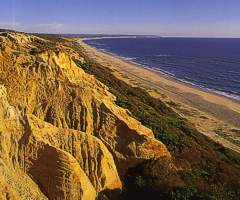 Still
in the Setùbal Peninsula, in addition to the coastline with its
townships, beaches, marshes and mountains, is the protected Arriba Fossil
area of the Costa da Caparica which is situated between Trafana and
the Lagoa de Albufeira. This area occupies an area of 1,570 hectares
and was so defined in 1984 because of its geological importance of sedimentary
rocks which form the river bank, some of which go back 15 million years
in time. The river bank dates from when the coastal line was further
inland. Nowadays, due to the accumulation of sediment along the coast,
the bank is in a fossilized state. The fossilized fauna on the bank
is diverse - fluviomaritime in nature one finds bivalves, gastropods
and traces of fish from the Miocene epoch. Still
in the Setùbal Peninsula, in addition to the coastline with its
townships, beaches, marshes and mountains, is the protected Arriba Fossil
area of the Costa da Caparica which is situated between Trafana and
the Lagoa de Albufeira. This area occupies an area of 1,570 hectares
and was so defined in 1984 because of its geological importance of sedimentary
rocks which form the river bank, some of which go back 15 million years
in time. The river bank dates from when the coastal line was further
inland. Nowadays, due to the accumulation of sediment along the coast,
the bank is in a fossilized state. The fossilized fauna on the bank
is diverse - fluviomaritime in nature one finds bivalves, gastropods
and traces of fish from the Miocene epoch. |
| THE NATIONAL MEDOS FOREST |
| Further interior, the National Medos Forest (Mata Nacional dos Medos) which, rumour has it, King John V ordered the plantig of to prevent the sands encroaching upon fertile ground. This area is classified a Botanical Reserve due to its significant floral content and unparalleled specimens of pine and juniper which make a superb recreation ground. |
| THE 'MATA DAS DUNAS' |
| The 'Mata das Dunas' in the Costa da Caparica was planted with various specimens of the acacia variety at the end of the last century and again in the sixties. The main reason was to immobilize the moving dunes characteristic of this area and also create attractive intervals to the beach, providing welcome recreational areas. |
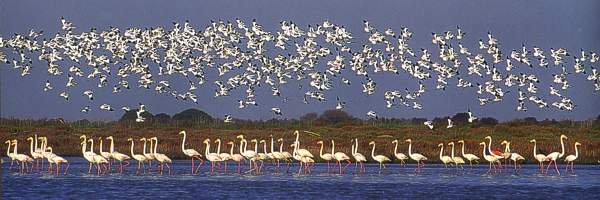
| Portugal > Tourism > Lisbon > Costa Azul > Nature and Environment |
|
Nature
and Environment |
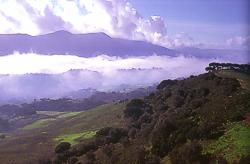 Along
the coast between Setúbal and Sesimbra, the Serra da Arrabida
stretches up. These chalky hills have the only surviving example of
primitive Mediterranean vegetation. Tucked away in the heart of Arrábida's
Natural Park, the formation goes back 180 million years. The soil
and mild climatic features, considered the best in Portugal, have
produced a lush vegetation rich in species.
Along
the coast between Setúbal and Sesimbra, the Serra da Arrabida
stretches up. These chalky hills have the only surviving example of
primitive Mediterranean vegetation. Tucked away in the heart of Arrábida's
Natural Park, the formation goes back 180 million years. The soil
and mild climatic features, considered the best in Portugal, have
produced a lush vegetation rich in species.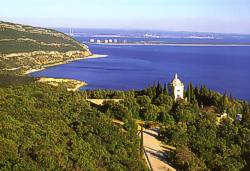 scene
of picturesque beauty with the lush green vegetation and the chalk
white face of the cliffs, such beauty which inspired poets like Sebastião
da Gama.
scene
of picturesque beauty with the lush green vegetation and the chalk
white face of the cliffs, such beauty which inspired poets like Sebastião
da Gama.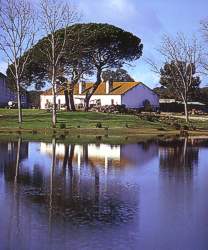 To the
south of the Setúbal peninsula, the Sado Estuary twists to
through diversified countryside. Huge rural properties connected to
agriculture and forestries, areas rich in fish and sea-food, salt
pans, urban occupation, buildings of great architectural and historical
value as well as dunes, marshes and areas rich in rushes.
To the
south of the Setúbal peninsula, the Sado Estuary twists to
through diversified countryside. Huge rural properties connected to
agriculture and forestries, areas rich in fish and sea-food, salt
pans, urban occupation, buildings of great architectural and historical
value as well as dunes, marshes and areas rich in rushes.